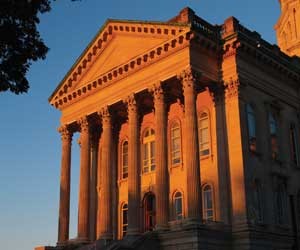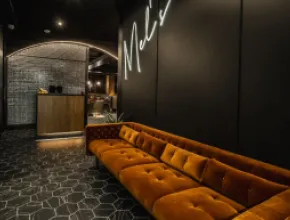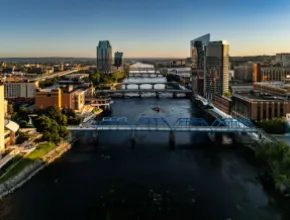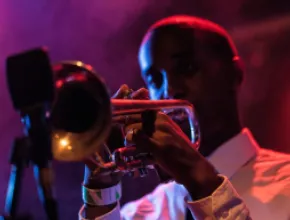Kansas will celebrate 150 years of statehood Jan. 29, 2011. In many ways the Sunflower State’s history is a microcosm of American history in the 19th and 20th centuries: battles over expansion and slavery, the Civil War, the Wild West, 20th century booms, busts and wars, the rise of air travel and the civil rights movement.
Kansas towns and cities are aware of this extraordinary diversity of historical experiences, and many highlight the state’s dynamic past for groups.
Topeka
Topeka’s Great Overland Station is a restored 1927 Union Pacific railroad station that today houses a railroad museum, education center and all-wars veterans memorial.
"The grand lobby is absolutely amazing: 34-foot ceilings, huge chandeliers and the [tile] flooring that would have been of that day," says Linda Briden, vice president of sales and marketing at the Topeka CVB.
Briden notes that restorers turned the baggage area into a mini-railroad museum with a 20-foot-by-20-foot miniature-train layout, and the station also features memorabilia from the Union Pacific’s glory days as a passenger railroad.
Groups can tour the station and accompanying facilities with docents dressed in Union Pacific uniforms or arrange to have lunch served by Harvey Girls, the legendary waitresses whose long black dresses introduced truly high-level service to Topeka and the West.
Another Topeka historic attraction is the Kansas State Capitol, finished in 1906, which is currently undergoing an extensive, $260 million renovation. Like Great Overland Station, it will recapture an original look and feel that included beautiful ceiling murals in the Senate chamber and elegant transom windows. Visitors can still walk to the top of the capitol dome and even outside of it for a panoramic view of the city.
Also, visitors interested in history could do worse than to meet on the 81-acre grounds of the Kansas Historical Society, which has various indoor and outdoor spaces for up to 300 people.
Finally, Topeka is home to the Brown v. Board of Education National Historic Site, which commemorates the U.S. Supreme Court ruling that ended legal segregation in public education. The site is located at the former Monroe Elementary School, which was directly affected by the outcome of Brown v. Board.
Wichita
Wichita styles itself the "Air Capital of the World" (see sidebar), but there’s a lot of historical interest in the ground as well. In the 1870s Wichita was a cow town, literally, since it served as an end point for Chisholm Trail cattle drives from Texas. The city’s remembrance of this period is centered on the Old Cowtown Museum. Features here include reenactors in period clothing who demonstrate both life as it was—hay rides, blacksmith shops—and a Hollywood version of the Wild West thanks to the museum’s Empire House Theater, where the Diamond W Wranglers sing for dinner guests.
The entire 24-acre museum is surrounded by trees and available to groups.
"You don’t notice the city is here; you are literally transported back to the 1870s," says Ken Vandruff, director of communications at the Greater Wichita CVB.
Similarly, the Mid-America All-Indian Center’s museum describes the trials and joys of Kansas Native Americans, and includes a large "kiva" meeting area festooned with the flags of many of the 500-plus recognized Native American tribes.
The Keeper of the Plains, a stylized, 44-foot steel sculpture of a Native American that has become a Wichita symbol, overlooks the confluence of the Arkansas and Little Arkansas Rivers from the MAAIC grounds. Spectacularly lit at night, the Keeper is even more attractive because of the nightly ring of fire that flares from a ring of rocks at its base.
Finally, the NAACP now recognizes that Wichita is the site of the first sit-in by African American students at an all-white lunch counter—years before the better-known Greensboro sit-ins. The students’ success after three weeks led to the desegregation of all Dockum and Rexall drugstores in Kansas.
Salina
Visitors to Salina may wonder why part of the city center is called the Historic Downtown Lee District. Salina was where Henry David Lee first began producing the dungarees and jackets that later became Lee Jeans in 1889. Although the company is now headquartered in the Kansas City suburb of Merriam, a beautiful Lee family home as well as one of the company’s first warehouses remain.
But the area is also a vibrant arts district, and the Smoky Hill Museum contains 20,000 artifacts ranging from the 1800s to today, including a sod dugout and an operating flour mill. The Stiefel Watson Theater has been restored to its 1920s glory and seats about 1,200, while the Bicentennial Center, featuring a 21,000-square-foot arena, the 18,000-square-foot Heritage Hall and eight meeting rooms, is also available for meetings.
Kansas City
Lewis & Clark were the first to formally map Kansas City, camping at Kaw Point on their way to the Pacific in 1804. Five decades later, the Kansas City area became a battleground as pro- and anti-slavery militias terrorized each other over whether Kansas would become a free or slave state. Following the Civil War, Kansas City was further plagued by Jesse James and other freelance bandits.
The city offers several sites that commemorate its 19th century origins, including Grinter Place Historic Site (the oldest European home in Wyandotte County) and the Quindaro Ruins and Overlook, which marks a free Missouri River port settled by a notably diverse population of European Americans, Wyandotte Indians and African Americans.
More recently—from a historical standpoint—the Strawberry Hill Museum and Ethnic Center is a Queen Anne-style home that documents the diverse contributions that Eastern European immigrants made here in the early 1900s. Its Tea Room serves authentic Slavic desserts and tea or coffee, and it also has a banquet room for up to 100.
Finally, the National Agricultural Center and Hall of Fame offers a Museum of Farming, a National Farmers Memorial, a Gallery of Rural Art and other exhibits under a Congressional charter to honor America’s farmers. Its Rural Electric Conference Center seats 200, while the Smith Event Barn accommodates up to 750.
Overland Park
Although Overland Park will only celebrate its 50th birthday in May 2010, this Kansas City suburb was the site of some rich history prior to its incorporation, and the Overland Park Historical Society offers a walking tour of what was once a very rural downtown.
Despite Overland Park’s relative youth, Overland Park CVB interactive marketing manager Amy Garton says the city is an excellent choice for history-centered tours of nearby communities.
"We would be a great hub-and-spoke for a historical meeting: Go and visit these historic attractions and come back and stay in nice modern facilities," Garton says.
She points to Olathe, which offers the Mahaffie Stagecoach Stop and Farm to commemorate the pre-rail days when horse power was the only power; the Kansas School for the Deaf, whose leatherwork program evolved into the famed Olathe Boot Company; and the Shawnee Indian Mission State Historic Site, which describes the trials and progress of Shawnee Indians transplanted here from Delaware.
Lawrence
Lawrence was a center of the pre-Civil War unrest known as Bleeding Kansas, as well as full-scale battles. Sacked in 1856 by pro-slavery forces, the town then endured Quantrill’s Raid in 1863, an attack by largely Missourian militias that resulted in many deaths and one in four Lawrence buildings being destroyed.
These calamities did have a silver lining, however: They forced Lawrence residents to band together to rebuild, and over a century later this prosperous city of 90,000 hosts the Douglas County seat as well as the University of Kansas.
The city’s visitor information center features a 25-minute docudrama that recounts Lawrence’s Civil War-era history, and visitors may take self-guided walking tours along the track of Quantrill’s Raid using city-provided iPods.
The Eldridge Hotel is a historic group venue that’s also a historic hotel, with 48 suites that are augmented by a ballroom for 150 and several other breakout spaces.
Another historic venue that might interest planners is Abe & Jake’s Landing, a restaurant and dance club housed within the former Consolidated Barbed Wire Factory building.
Manhattan
Like Topeka, Manhattan also has a restored Union Pacific depot downtown, in this case with some original train tracks out front.
"The train depot is used a lot for smaller business meetings, but is beautifully renovated with hardwood floors," says Summer Dierks, convention sales manager at the Manhattan CVB.
Groups may also enjoy the historic Wareham Theatre, renovated in 1910 from its previous life as an opera house and still thriving as a dinner theater; the Pioneer Log Cabin in City Park; and the Riley County Historical Museum, which illuminates the area’s history from the days of the European pioneers on.
Manhattan is also home to Kansas State University, and visitors who need larger or more-modern facilities should consider the school’s new alumni center for groups of up to 1,200, as well as the KSU Student Union building for additional meeting space.
Dodge City
Nothing says Wild West like Dodge City, partly thanks to TV shows such as Gunsmoke but also to actual history. A new railroad caused the city to suddenly blossom as a cattle-export hub, creating a parallel boom in saloons, brothels and gambling halls that worked hard to separate cowpunchers from their money.
Today, historic Front Street features a Trail of Fame commemorating Dodge Cityans both real and fictional. However, the Boot Hill Museum is Dodge’s largest attraction and is located on the site of the original Boot Hill cemetery. Visitors can stroll by some markers that remain from the historic cemetery, so named because its inhabitants tended to die with their boots on.
Visitors can also see the interdenominational Union Church where both Wyatt Earp and "Bat" Masterson were deacons, and pause for a variety show and a beer or sarsaparilla at the Long Branch Saloon. Outside, visitors can witness gunfights in the streets—at high noon, of course.
—Paul D. Kretkowski writes frequently about travel, food and sports. He is also the founder of Beacon (www.softpowerbeacon.blogspot.com), a blog about foreign policy.






